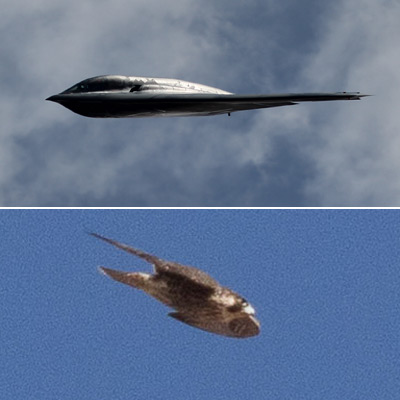Inspired by God’s creation mandate in Genesis 1:28, humans across the centuries have sought ways to optimize processes, solve problems, and ultimately “subdue” the world for our benefit. The quest to observe and record the laws of nature has taught us many helpful concepts in a variety of fields, particularly in topics related to science and technology.
One example is aerodynamics, the study of forces and resulting motion of objects through the air.1 Specifically birds have provided considerable insight into the principles that influence aircraft design. These incredible animals were created with different types of wings that adapt to thrust, drag, lift, and weight—the four basic forces involved in flight. Delta wings, for instance, were inspired by birds of prey like the peregrine falcon. This bird’s ability to curve its wings backward and align them close to its body reduces drag, allowing it to swoop down with rapid velocity.

The delta wing structure is especially common among high-speed aircraft like the B-2 Spirit. This stealth bomber has many similarities to a peregrine falcon in both shape and performance. It features sleek wings that minimize drag and improve speed, and its ability to hit marked targets parallels the skill of a falcon on the hunt.2 Because the plane was designed for covert missions, it employs sophisticated aerodynamics to reduce radar cross-section and boost maneuverability—similar to the precision and agility of a swooping bird through the air. Its design also incorporates features that reduce its radar signature, so though not completely silent like a falcon, the B-2 operates with a high level of stealth.3 Furthermore, just as falcons adjust their wings to accommodate flight conditions, this aircraft has geometric wings that can be configured for different flight phases.
Clearly, the design of peregrine falcons has influenced the unique engineering of the B-2 Spirit bomber—one of the most iconic planes in the U.S. military arsenal. If human inventions like bird-inspired aircraft illustrate design, how much more the birds themselves! To this point, Romans 1:18–25 conveys the idea that everyone, including scientists, can recognize the God-designed complexity of nature.4 Our experiences with the handiwork that we see around us make it impossible to deny His agency.5 As we note the use of design elements borrowed from the natural world, it’s not “Mother Nature” (the creation) that deserves the credit but God (the Creator). Truly, He is the God “who created the heavens and stretched them out, who spread forth the earth and that which comes from it, who gives breath to the people on it, and spirit to those who walk on it” (Isaiah 42:5).
References
- Wei Shyy et al., An Introduction to Flapping Wing Aerodynamics (Cambridge: Cambridge University Press 2013).
- Alexander Lippisch, The Delta Wing: History and Development (Iowa City: Iowa University Press, 1981).
- Abhishek Sawant, “B-2 Bomber: Nature-Inspired Design Marvel!” Medium, December 19, 2023.
- Workmanship is emphasized in this passage as well as Psalm 19:1–6. Nature exhibits characteristics that are exclusive to the design agency observed in the efforts of artists or engineers. However, since nature's workmanship cannot be of human origin, it is reasonable to attribute causality to God’s handiwork.
- Randy J. Guliuzza, “Engineering Principles Point to God’s Workmanship,” Acts & Facts, June 2017, 16–19.
Stage image: United States Air Force B-2 Spirit
Stage image credit: Copyright © Royal Air Force; OGL v1.0. Used in accordance with federal copyright (fair use doctrine) law. Usage by ICR does not imply endorsement of copyright holder.
* Dr. Corrado earned a Ph.D. in systems engineering from Colorado State University and a Th.M. from Liberty University. He is a freelance contributor to ICR’s Creation Science Update, works in the defense and nuclear industries, and is a senior officer in the U.S. Naval Reserve.







